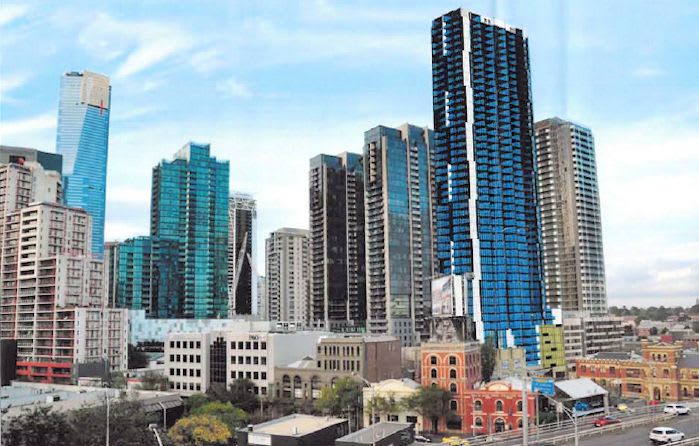Central Equity seeking size > 1-11 Balston Street, Southbank
The Future Melbourne (Planning) Committee will tomorrow consider the merits of one of two proposed towers that prolific Melbourne-based apartment developer Central Equity currently has under consideration with State planning body DTPLI. While the nearby 54-68 Kavanagh Street has been reported to be 165 metres, Central Equity have also sought to extend a previously approved scheme at 1-11 Balston Street, Southbank.
Marking the final and potentially tallest stage of the Southbank Central/Blood Bank super-site development which began in excess of twelve years ago, 1-11 Balston Street has raised a number of concerns within a report which provides guidance to the Future Melbourne (Planning) Committee.
Planning application summary
- Current site use: Central Equity display suite.
- Application for amendment lodged July 2014.
- Developer & architect: Central Equity.
- 48-storey building with residential apartments at 147.7 metres.
- 557 apartments (336*1 / 169*2 / 51*3).
- 269 car parking spaces & 389 bicycles.
- GFA: 52,616sqm.
Sized up
Initial plans had seen a 34 level residential tower given the green light which was to have contained 382 apartments with 150 two bedrooms options. The revised application seeks 557 apartments with two bedrooms options increasing marginally to 169 as one bedroom dwellings more than double from 142 in the initial scheme to 336.
The increase in height from 104.65 metres to 147.7 metres has brought with it the issue of overshadowing according to the report. Directly to the west lies the former JH Boyd School site which has essentially been portioned into three sections, two of which are a community centre and proposed urban park.
The report notes that in general, local policy suggests any development should not reduce the amenity of public spaces by casting any additional shadows, even though the expected urban park is slated for construction during 2016.
Podium poppycock?
As a result of the increased building height and increased number of apartments from 382 to 557, the building services have been revised including the relocation and increase in the size of the substation from Balston Street non-heritage fabric (as currently approved) to City Road
It is now proposed to accommodate an enlarged substation within two of the existing openings in the City Road remnant heritage façade.
Report to the Future Melbourne (Planning) Committee
In addition angular awnings have been added to the heritage facade in order to negate increased wind conditions due to the taller tower. The glass and alucobond clad steel framed awning seeks to replace a pergola style louvre and sunshade system at podium terrace level, and canvas awnings at ground level.
This coupled with the loss of the two aforementioned City Road facade openings will lead to an adverse impact on the heritage façade and reduction in active street frontages according to the report.
City of Melbourne advised to reject
Although not a binding decision, the Report to the Future Melbourne (Planning) Committee recommends that a letter be sent to DTPLI advising that the City of Melbourne objects to 1-11 Balston Street.
The proposed increase in height is inconsistent with the 100m height limit for the area, would increase overshadowing of the proposed park, and would exacerbate wind conditions (resulting in inappropriate awnings).
Further, the increased number of apartments would generate increased demand in ground floor service areas, resulting in decreased active frontages on City Road, loss of a street tree, and unacceptable intrusion into the retained heritage fabric.
Report to the Future Melbourne (Planning) Committee
Comment
More a general observation but what can be deduced from the general design ethos Central Equity employs? Certainly the repetitive nature of their recent towers, namely Southbank Grand, Australis and Melbourne One are also reflected in the heightened 1-11 Balston Street design.
From afar it seems they are intent on producing a higher volume of apartments while implementing a degree of design simplicity; A to B with minimum fuss which to my way of thinking draws a parallel to the low-cost airline model?
This segment of the market exists and Central Equity clearly have a winning formula given the rate at which the firm can release, sell and realise their projects in rapid succession; in fact their efficiency is impressive. But what are the consequences of having masses of generic towers churned out with monotonous regularity?
Some would argue look no further than Southbank, although with their current projects and the purchase of the 556-566 Lonsdale Street and 13-25 Healeys Lane development site, Central Equity continues to push into the CBD. Central Equity have over their history gradually increased the size of their towers to currently sit in the 145-165 metre bracket; what prospects of a Central Equity-designed 200 metre tower in the not too distant future?
